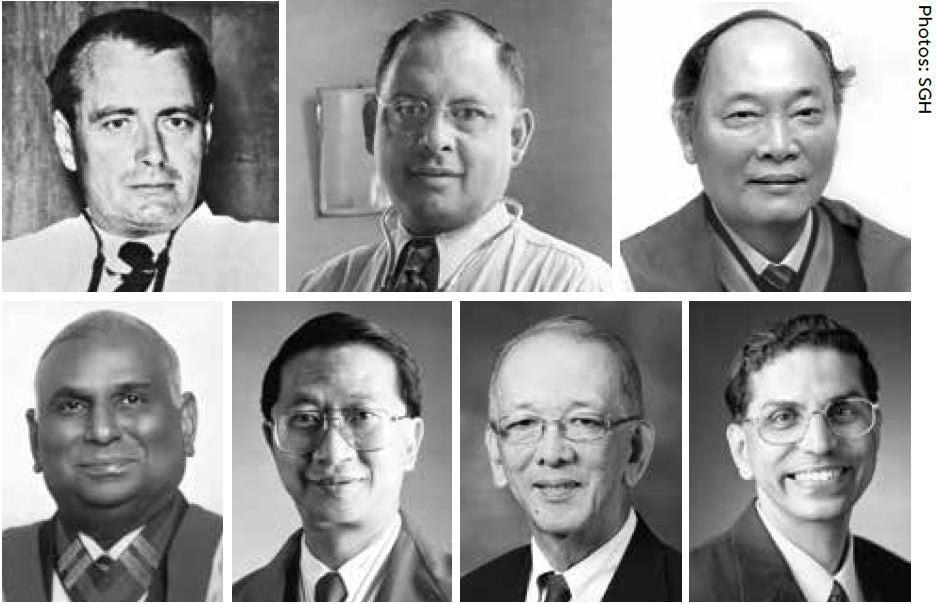
(Clockwise from top left) Professor Gordon Ransome, Professor Ernest Monteiro, Professor Seah Cheng Siang, Professor V Anantharaman, Professor Lee Seng Teik, Professor Tan Ser Kiat, Professor Navaratnam Balachandran.
It is not enough to have brilliant clinicians. They have to share a common purpose in ensuring their knowledge, skills and experiences are preserved through the generations.
Some of their teaching methods were decidedly unorthodox. But all of them shared the same purpose — to pass on their knowledge, skills, and importantly, their experiences and values. One of the earliest documented and greatest clinicians and teachers to have passed through the portals of Singapore General Hospital (SGH) is Professor Gordon Arthur Ransome (1910-1978). Born in the UK at the turn of the last century, Sir Ransome came to Singapore in the early 1900s.
The story of Sir Ransome dipping a finger into urine and tasting for diabetes is legendary. His students were tricked into doing likewise but Sir Ransome had actually used two different fingers. The lesson was on the importance of observation in medicine — one that his students were unlikely to forget in a hurry! It is also a great story that has been passed — together with other lessons — down the generations.
Successive generations of doctors may not have resorted to such unconventional ways, but SGH’s long reputation as a teaching hospital is without doubt. Many of Sir Ransome’s students became legends in their own right.
Professor Seah Cheng Siang (1922-1990) inherited much of Sir Ransome’s teachings and values. He regarded care of patients — regardless of their standing — as priority, with the same thoroughness and humility in all ways. He attended to a subsidised patient needing emergency care, keeping then-President Benjamin Sheares waiting.
Professor Navaratnam Balachandran (1928-2000) was another highly respected and sought-after teacher. SGH Emeritus Consultant Professor Tan Ser Kiat, whom he mentored, recalled Prof Bala frequently stressing that “one of our greatest responsibilities as senior staff is the training of our younger colleagues. To be allowed to teach and train itself is a privilege and honour, which we must uphold”.
Like Prof Bala, Prof Tan believes clinicians must always aim for excellence and generosity in imparting knowledge. Seniors are successful in training their younger counterparts well only when the latter surpasses their teachers in both skills and knowledge. Prof Tan is particularly passionate about raising the quality of medical education and mentoring of young doctors.
Professor Ernest Steven Monteiro (1904-1989) played a large part in establishing Singapore’s very high standard of medical practice. He was held in great esteem by his students, who included former Malaysian Premier Tun Dr Mahathir Mohamad. Like all SGH’s greats, Prof Monteiro was known just as much for his research into better treatments and care. His major discoveries included obtaining vitamin B1 extract for the potentially fatal beriberi, common among impoverished Chinese dockworkers subsisting on polished white rice; and diptheria antitoxin to combat an epidemic then spreading throughout Singapore.
More recently, Emeritus Consultant Professor Lee Seng Teik pioneered cleft lip and palate procedures, notably the Manchester-Lee Repair for reconstructing bilateral cleft lip deformity. Meanwhile, Emeritus Consultant Professor Venkataraman Anantharaman has passed on resuscitation medicine and out-of-hospital cardiac arrest work to a younger generation specialising in emergency medicine.
To keep healthcare professionals abreast of the latest developments in medicine, SGH established the Postgraduate Medical Institute (1994), the Postgraduate Allied Health Institute (2003), and the SingHealth Alice Lee Institute of Advanced Nursing (1997). The Duke-NUS Medical School was set up in 2005, a century after Singapore’s first medical school.
Simulation facilities, using the latest technology and equipment, offer advanced and specialist skills training in situations involving emergencies and various medical conditions at a mini hospital equipped with an operating theatre, intensive care unit, and clinics.
Follow the celebrations at www.sgh.com.sg/sgh200 and on our social media platforms: Facebook (@SingaporeGeneralHospital), Instagram (@sghseen) and TikTok (@sghseen).













 Get it on Google Play
Get it on Google Play